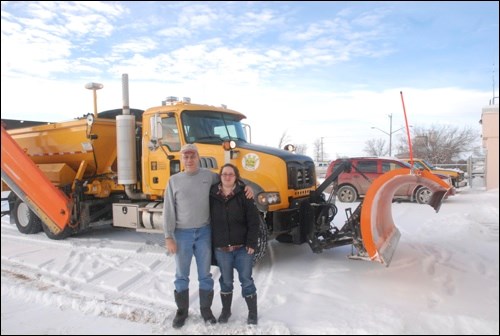It's 5:30 in the morning and, while I'm still in bed thinking about how much I hate Mondays, the snowplows are already out and about, clearing the highways.
"We've got to be working on the interchange by 5:30 at the latest, or traffic just gets too crazy," said Don McNie, who has been working with the North Battleford section of the Ministry of Highways and Infrastructure since 1977.
He explains the interchange, which connects North Battleford and Battleford and where Highway 16 passes through the Battlefords, takes about an hour to clear with six or seven plows working on it.
Fortunately for me, I don't get the call to head down to the ministry office until 9 a.m.
When I get there, Alan Hoffman, area manager, takes me on a tour of the facility, which includes a fully-staffed shop for equipment repairs and maintenance.
Alan tells me there are 300 plows in the province, which is split up into 15 areas.
The North Battleford section has 10 plows, which clear roads as far north as Glaslyn, east to Maymont, south to Wilkie and west to Maidstone, for a total of 736 kilometers of highway.
The highways in this area are divided into three levels of priority, with Level 1 highways СŔ¶ĘÓƵ cleared within six hours after a storm quits, Level 2 within 12 hours and Level 3 within 24 hours - no small feat for a 10-person crew.
"We have to work with the amount of trucks we have," he said.
Alan shows me a typical plow truck, with a front and wing plow. He points out a newer feature, a reflective checkered board on the rear of the truck with a wind scoop above it, designed to make the snow plow as visible as possible.
"We're trying to do everything we can," said Alan. "We've got lots of lights on the truck."
Even so, it seems people are fond of hitting snowplows, which, if you pay attention to the news, happens all too often.
When I head out on Highway 16 with Don, he tells me about the time he was hit by a half-ton truck. Don was clearing the left lane of Highway 16 and a semi was passing him on the right. The half-ton decided to pass the semi, thinking the snow plume was all from the semi.
"If it's just a car or a truck, they usually come out of it a lot worse than we do," said Don. "Semis - it's a different story."
Don said he prefers clearing the four lane highway because he doesn't have to worry about oncoming traffic. He also prefers clearing snow to sanding, because he has to drive more slowly while sanding, which can be a bit hair-raising when cars are sliding all over the highway.
Don added he pulls over or slows down every three or four miles to let drivers pass safely, but most of the time, drivers won't wait that long.
The snowplows travel at approximately 70 km/hr when clearing snow, slower if the snow is wet.
Don explains -15 to -20(C is the ideal temperature, adding in warmer weather the snow sticks to the road and is harder to clear. Also, when the snow is slushy, the plow will sometimes hit a wet spot and want to dig in, which Don says can result in a plow winding up in the ditch.
"If you haven't bent anything or broken anything or gone in the ditch, you haven't been doing it long enough," said Don.
He tells me about biters or nibblers, uneven patches of asphalt which, when hit with the wing plow, can "give you a bit of a jolt."
While clearing snow may seem like a monotonous job, Don said it gives him a chance to think, listen to music and "listen to John Gormley and freak out at him once in a while."
When Don started with the ministry back in 1977, fresh out of school, minimum wage was $1.90, while the ministry paid $5. He said it's a job he's continued to enjoy, and, if it does border on boring, that's just the way he likes it.
"It can be hours of boredom followed by 10 seconds of terror," said Don of the close calls he's had with irresponsible drivers.
In an effort to prevent collisions with snowplows, the Ministry of Highways and Infrastructure launched a campaign last November called Stay Back and Stay Safe.
"People really have to be cautious," said Alan, adding with the whiteout left in a snowplow's wake, people often don't see the plow until it's too late.
So next time you see a flurry of snow and think you can pass through it at 140 km/hr, just think: you could hit a snowplow and die. Or even worse: you could injure an intrepid reporter on board the snowplow and then your newspaper would be boring until she recovered.




